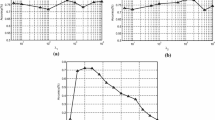Abstract
This paper proposes a novel dimensional reduction method, called discriminant graph nonnegative matrix factorization (DGNMF), for image representation. Inspired by manifold learning and linear discrimination analysis, DGNMF provides a compact representation which can respect the original data space. In addition, In addition, the within-class distance of each class in the representation is very small. Based on these characteristics, our proposed method can be viewed as a supervised learning method, which outperforms some existing dimensional reduction methods, including PCA, LPP, LDA, NMF and GNMF. Experiments on image recognition have shown that our approach can provide a better representation than some classic methods.



Similar content being viewed by others
References
Murase H, Nayar SK (1995) Visual learning and recognition of 3-D objects from appearance. Kluwer Academic Publishers, Norwell
Turk M, Pentland AP (1991) Face recognition using eigenface. IEEE Conf Comput Vis Pattern Recognit 118(5):586–591
Batur AU, Hayes MH (2001) Linear subspaces for illumination robust face recognition. In: Proceedings of the 2001 IEEE computer society conference on computer vision and pattern recognition, 2001. CVPR 2001
Martnez AM, Kak AC (2009) PCA versus LDA. IEEE Trans Pattern Anal Mach Intell 23(2):228–233
Shakunaga T, Shigenari K (2001) Decomposed eigenface for face recognition under various lighting conditions. In: Proceedings of the 2001 IEEE computer society conference on computer vision and pattern recognition, 2001, vol 1, pp I-864–I-871. CVPR 2001
Belhumeur PN, Hespanha JP, Kriegman DJ (2002) Eigenfaces vs. fisherfaces: recognition using class specific linear projection. IEEE Trans Pattern Anal Mach Intell 19(7):711–720
He X, Niyogi P (2003) Locality preserving projections. Adv Neural Inf Process Syst 16(1):186–197
Lee DD, Seung HS (1999) Learning the parts of objects by non-negative matrix factorization. Nature 401(6755):788–791
Pauca VP, Shahnaz F, Berry MW, Plemmons RJ (2004) Text mining using non-negative matrix factorizations. In: SIAM international conference on data mining, Lake Buena Vista, Florida, USA, April, 2004
Cichocki A, Zdunek R, Amari S (2006) New algorithms for non-negative matrix factorization in applications to blind source separation. In: IEEE international conference on acoustics, speech and signal processing, 2006. ICASSP 2006 Proceedings, pp V–V
Hoyer PO (2002) Non-negative sparse coding. In: Proceedings of the 2002 12th IEEE workshop on neural networks for signal processing, 2002, pp 557–565. IEEE
Tong M, Bu H, Zhao M, Xiand S, Li H (2017) Non-negative enhanced discriminant matrix factorization method with sparsity regularization. Neural Comput Appl 2:1–24
Zhang Z, Shi Z (2013) Nonnegative matrix factorization-based hyperspectral and panchromatic image fusion. Neural Comput Appl 23(3–4):895–905
Lin CJ (2007) Projected gradient methods for nonnegative matrix factorization. Neural Comput 19(10):2756–2779
Xu W, Liu X, Gong YH (2003) Document clustering based on non-negative matrix factorization. In: SIGIR 2003: proceedings of the international ACM SIGIR conference on research and development in information retrieval, July 28–August 1, 2003, Toronto, Canada, pp 267–273
Yang S, Hou C, Zhang C, Wu Y (2013) Robust non-negative matrix factorization via joint sparse and graph regularization for transfer learning. Neural Comput Appl 23(2):541–559
Cai D, He X, Han J, Huang TS (2011) Graph regularized nonnegative matrix factorization for data representation. IEEE Trans Pattern Anal Mach Intell 33(8):1548–1560
Chen WS, Zhao Y, Pan BB, Chen B (2016) Supervised kernel nonnegative matrix factorization for face recognition. Neurocomputing 205(C):165–181
Liu H, Wu Z, Cai D, Huang TS (2012) Constrained nonnegative matrix factorization for image representation. IEEE Trans Pattern Anal Mach Intell 34(7):1299–1311
Pierre C (2007) Fast Newton-type methods for the least squares nonnegative matrix approximation problem. SIAM Int Conf Data Min 1(1):38–51
Han L, Neumann M, Prasad U (2009) Alternating projected Barzilai–Borwein methods for nonnegative matrix factorization. Electron Trans Numer Anal 36:54–82
Guan N, Tao D, Luo Z, Yuan B (2012) NeNMF: an optimal gradient method for nonnegative matrix factorization. IEEE Trans Signal Process 60(6):2882–2898
Che H, Wang J (2018) A nonnegative matrix factorization algorithm based on a discrete-time projection neural network. Neural Netw 103:63–71
Nesterov Y (1983) A method for unconstrained convex minimization problem with the rate of convergence \(O(1/k^2)\). Sov Math Dokl 27(2):372–376
Nesterov Y (2004) Introductory lectures on convex optimization. Appl Optim 87(5):236
Nesterov Y (2005) Smooth minimization of non-smooth functions. Math Program 103(1):127–152
Nesterov Yu (2007) Gradient methods for minimizing composite objective function. Core Discuss Pap 140(1):125–161
Bertsekas DP (1999) Nonlinear programming. Athena Scientific, Belmont
Author information
Authors and Affiliations
Corresponding authors
Rights and permissions
About this article
Cite this article
Dai, X., Chen, G. & Li, C. A discriminant graph nonnegative matrix factorization approach to computer vision. Neural Comput & Applic 31, 7879–7889 (2019). https://doi.org/10.1007/s00521-018-3608-9
Received:
Accepted:
Published:
Issue Date:
DOI: https://doi.org/10.1007/s00521-018-3608-9




